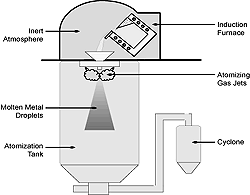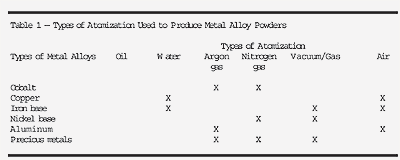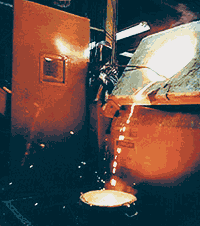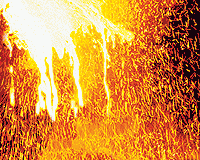Manufacture of Braze and Solder Alloy Powders by Atomization
A key component in the success of brazed or soldered joints is how the alloy is made and the quality it brings to the process
Most brazing and soldering operations start with the application of an alloy powder to the parts. This can be in the form of a paste, slurry, spray, tape, or preform, all of which begin as a powder. How the powders are manufactured can impact the cost, quality, and success of soldered and brazed components. Understanding how the powders are manufactured and sized can help one make decisions on the alloy powder to use and how best to apply it to the parts to be soldered or brazed.
A number of manufacturing processes are used to produce metal powders. These processes include sintering, crushing, spray drying, cladding, and atomization. While all of these methods produce excellent forms of powder, atomization produces powders that meet the extensive requirements of the brazing and soldering processes - Fig. 1.

Fig. 1 - Spherical, gas-atomized nickel braze alloy particles.
Defining the Atomization Process
Atomization of molten metal is similar to the atomization of perfume. A liquid stream of perfume is hit with air to break up the liquid into millions of tiny drops that deposit on the skin as a fine mist. With metal powder production, the process is essentially the same. The molten metal stream is hit by a jet stream of air or other material and broken up into tiny drops, each of which contains all of the elements of the molten metal. The droplets cool and shrink to form powder particles.
The jet of air, as the way to break up the stream of liquid metal, can be replaced with other materials such as oil, water, or gases like argon, nitrogen, or helium. The powder manufacturing process itself can be accomplished in air, under vacuum, or under cover of a shielding gas such as those mentioned above. In every case, a high-quality braze or solder alloy powder is produced.

Fig. 2 - Schematic of a gas-atomizing induction furnace.
Choosing the method to manufacture a solder or braze alloy powder depends on the type of metals that make up the alloy powder. As you can imagine, the process to make a titanium-beryllium braze alloy is different than that for making a palladium-nickel braze alloy or a copper-tin-lead solder alloy. The temperatures required to melt the metals and the oxidation levels or properties of the finished powders are examples of some of the reasons one process is chosen over another to make these powders.
Table 1 shows the base metal alloy powders and the various atomization processes used to manufacture them.
How Does It All Start?
It begins with a recipe.
The recipe, which is actually the processing or job card, is based on internal or external chemistry and size specifications for the solder or braze alloy powder. It details the exact amount of each raw material component needed to produce the powder. An example of chemistry for a recipe might be something like the following:
60% Nickel
14% Nickel Boron
10% Ferrochrome
8% Silicon
5% Iron
3% Chromium

Of course, the quality of the powder actually starts with the purchase of raw materials. Knowing the reliability of the supplier and the quality level of the raw materials will provide consistent product realization and ensure the braze and solder metal powders function as expected and meet the requirements of the industry specifications. As added insurance, most raw materials are retested prior to use in the production of the alloy powders.
Atomization Process
The atomization process is controlled from start to finish through detailed job instructions, control checks at each step in the process, and extensively trained operators. Production controls can include accurate weights on the raw materials and monitoring of the melting temperature, gas pressures, water temperatures, pour time, and gas levels. Also important is the training and skill level of the production operators. Effective training can take 6 to 12 months for a new operator to become proficient at the melting/atomizing process. Essential to the success of the atomization of powder alloys is the documentation of the processes and practices of production.

Fig. 3 - Refractory-lined furnace starting to pour the liquid metal for atomization.
Step one of the atomization process is the melting of the raw materials or melt stock. If using raw material, the exact amount of each component is weighed and combined in a container that will hold the total weight. This is referred to as a "furnace charge." It is possible, and sometimes desirable, to purchase melt stock that is premelted and contains most or all of the elements of a braze or solder alloy. This becomes the furnace charge that is melted and turned into alloy powder. A refractory furnace is used because it can withstand the heat required to melt metal alloys. The melt temperature can vary from 71°C (160°F) for low-temperature solder alloys to almost 1650°C (3000°F) for high-temperature braze alloys. The heat source for melting can be induction (electric) or gas and is introduced so that the entire furnace charge is heated uniformly. The furnace operator carefully monitors the melting process using temperature measurements and visual exams until the furnace charge has become completely molten and the temperature necessary for all the elements to become homogeneous has been achieved. Often, reactive elements such as rhenium, hafnium, yttrium, zirconium, and rare earths are added very late in the melting process to keep them from being dissolved rather than melted.
Figure 2 is a schematic of a typical induction furnace used for gas atomization of nickel-, cobalt-, and copper-based alloy powders. Similar furnaces are used for all types of alloy powders.
Once the metals are liquified and ready to pour, the furnace is tipped and the molten stream is poured into a chamber where the atomization takes place - Fig. 3. This is a rather dramatic operation as the hot liquid metal is hit with a stream of air, oil, or gas and broken up into millions of tiny droplets - Fig. 4. The droplets are then cooled in air, gas, or water to form powder particles.
Screening of Powders
The specialization of the atomizing equipment can help to optimize the range of the droplet sizes that are formed from the exploded metal stream of alloy. But, even under the best conditions, the sizes of the powder particles created from this process range from 5 to 600 microns (0.0002 to 0.023 in.). From this wide range of particle sizes, the desired particles, defined by internal and external specifications, must be separated and collected to create the end product that will be delivered to the brazing and soldering customers. The "product" could be as little as 20% or as much as 50% of the powder produced in the atomizing process. This is determined by how tight the particle size specifications are for the powder, and will be discussed later. Sizing of powders is accomplished by screening, and various types of screening equipment are employed. It is not unusual for two different types of equipment to be used to produce one braze or solder powder.

Fig. 4 - Hot droplets of liquid metal formed during the atomization process.
Screening is a method utilized to separate powders into size fractions in order to collect and deliver the product as defined by the specifications. Just as the name suggests, the process uses screens similar to those on windows and doors. They are made of steel or nylon materials woven to have a specific size hole and are based on a specific number of holes per square inch - Fig. 5. For efficiency, the screening process is designed to siz
[1] [2] [3] Next


